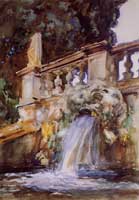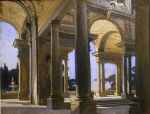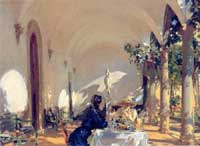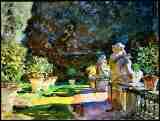Villa
di Marlia, Lucca:
The Balustrade
John
Singer Sargent
-- American painter
1910
Museum
of Fine Arts,
Boston
Transparent
and opaque watercolor over graphite pencil, with wax resist on paper
40 x 52 cm (15 3/4 x 20 1/2 in.)
The Hayden Collection–Charles Henry Hayden
Fund
12.228
Jpeg MFA
(See
interactive zoom
at the MFA)
This was painted in
one of the villa
di Marlia near Lucca. He painted many like this in Tuscany and
around
Rome. He combines the elegance of the architecture with the
foliage  of
the garden -- the post and the balustrade actually occupying a greater
importance in this composition. of
the garden -- the post and the balustrade actually occupying a greater
importance in this composition.
This simplicity and
grandeur, cleanness
and harmony are fundamental elements which run throughout his creative
mind. A man now in his fifties, mature in his style, has never fully
left
his roots of his twenties and the classical formal training he received
at the Ecole
des Beaux-Arts which put strong importance upon the study of
classical
design -- Greek, Roman Antiquity and the Italian Renaissance.
 Although
as a young man he never won the coveted Prix de Rome Contest -
the
prize to study in Rome and paint the Great Masters and architecture in
and around -- it was something he did on his own and throughout his
travels.
It was, for him, an exercise in creative dexterity which he would never
leave. These paintings are a constant vigilance at keeping his
faculties
sharp for observation of the world around him. Although
as a young man he never won the coveted Prix de Rome Contest -
the
prize to study in Rome and paint the Great Masters and architecture in
and around -- it was something he did on his own and throughout his
travels.
It was, for him, an exercise in creative dexterity which he would never
leave. These paintings are a constant vigilance at keeping his
faculties
sharp for observation of the world around him.
To the Italian
Renaissance architects,
gardens were a balance between "Art" (the  regular
form of intended controlled growth) and "Nature" (the
irregularity
of unplanned and undisturbed outgrowth); and the relationship between
human
thought and human effort. This balance was asserted in symmetry within
the entire site of buildings and gardens -- one was never wholly
separate
from the other. Transitions from interior to exterior were sometimes so
subtle a person might not know when they were leaving the house and
entering
the garden -- or leaving the garden and entering the regular
form of intended controlled growth) and "Nature" (the
irregularity
of unplanned and undisturbed outgrowth); and the relationship between
human
thought and human effort. This balance was asserted in symmetry within
the entire site of buildings and gardens -- one was never wholly
separate
from the other. Transitions from interior to exterior were sometimes so
subtle a person might not know when they were leaving the house and
entering
the garden -- or leaving the garden and entering the  house.
Architectural elements, such as a balustrade, in this case, were
carried
outwards and themes of the garden were carried within. These elements
and
themes, gradually lessened respectively as one
explored deeper until
you
would either find yourself at the outer bonds of unplanned nature or
within
the fully designed inner rooms of the home. [1] house.
Architectural elements, such as a balustrade, in this case, were
carried
outwards and themes of the garden were carried within. These elements
and
themes, gradually lessened respectively as one
explored deeper until
you
would either find yourself at the outer bonds of unplanned nature or
within
the fully designed inner rooms of the home. [1]
 As
always, John was not painting in a vacuum. Although they were often
done
for his own pleasure, interest in Italian Renaissance gardens were at a
forefront of the public's eye. This is a subject matter he took up on
his
trips to that part of the world starting in 1900, and would grow in
importance
as interest in American Renaissance Movement grew. Formal arrangements
for gardens were becoming more desired to complement the buildings
of
architects such as Charles McKim and Richard
Moris Hunt. As
always, John was not painting in a vacuum. Although they were often
done
for his own pleasure, interest in Italian Renaissance gardens were at a
forefront of the public's eye. This is a subject matter he took up on
his
trips to that part of the world starting in 1900, and would grow in
importance
as interest in American Renaissance Movement grew. Formal arrangements
for gardens were becoming more desired to complement the buildings
of
architects such as Charles McKim and Richard
Moris Hunt.
Surprisingly
enough, up to Sargent's
time, the gardens of Italy were virtually unexplored by scholars. There
had been one serious study by two Frenchmen -- Percier and Fontaine
back
in 1824 [2], (never
really distributed
outside of France) but it didn't compare to the well photographed (for
that time) and documented treatise by two young Americans -- Charles A.
Platt and his younger brother William Platt in 1893. Charles published
their findings for Harper's Magazine in two installments that year and
then in a book called "Italian Gardens" the following year. [3]
By the turn of the
century, interest
in the City Beautiful Movement was reaching critical mass. Some of the
principle figures had come together in Washington D.C. for the
McMillian
Commission of 1901. Daniel H. Burnham, Frederick Law Olmsted Jr. (who
was
carrying on in his father's footsteps), Charles Moore, Augustus
Saint-Gaudens, and Charles McKim (the latter two of the Boston
Public Library fame) all presented their ideas for a comprehensive
and inclusive formal design of Washington D.C.'s central mall which
brought
together a hitherto fragmented conglomerate of parks and structures.
They
embraced the Classical Renaissance idea that gardens and buildings
should
exist in a symmetrical harmony. In a sense, they were carrying forward
what had been done at the World
Columbian Exposition of 1893.
There
was an
awakening in the popular
public. The acclaimed Edith Wharton, whom had been sending back
travelogue
articles of her trips for magazines such as Century and Harper's, in
1904
published her own very successful book "Italian Villa and Their
Gardens"
illustrated by Maxfield Parrish [4].
By 1910, interest in the American Renaissance Movement had reached its
zenith, and probably best expressed by the palatial estates of James
Deering's Florida "Villa Vizcaya" and Harold
F.
McCormick with his wife Edith Rockefeller (daughter of John
D.'s) "Villa
Turicum" at Lake Forest, IL. which sat overlooking
Lake Michigan with begining designs started by Frank Lloyd Wright
but really brought to fruition by Charles A. Platt -- the very
same
Platt who had published his "Italian Gardens" in Harper's some
seventeen
years previous.
We had come full
circle.
None of this would
have escaped John's
brilliant cognitive mind. Many of these people were friends or
acquaintances.
The people paying for these colossal residences were the same who
begged
for portraits. The men of the City beautiful Movement were his friends,
and in many cases fellow alumni of the Ècole
des Beaux-Arts.
America had come a
long way since Richard
Moris Hunt's
mother asked if the country was even ready for the Arts. Artisans were
employed in an unprecedented level of involvement. Herman Mueller
designing
gorgeous ceramic tile mosaics, Tiffany turning out breathtaking stain
glass
and silver, Augustus
Saint-Gaudens, creating intricately cut stone sculptures and
interior
wood moldings and mantel pieces; Many of his friends from the Broadway
colony days were doing mural work for new classically designed
state
capital buildings, city halls, libraries, monumental train stations,
new
governor's mansions all over the country. Frank
Millet was active at the highest levels, coordinating efforts for
the World
Columbian Exposition, sitting on boards of major art institutions.
John, himself had risen to the highest levels in the Royal
Academy.
American artists
were taking the
best of what the history of western culture had to offered, bringing it
home, adapting it and making it their own, building upon a the rich
wealth
of ideas in a manner and fashion unseen since the Italian Renaissance.
The stars had
finally aligned in
the sky. Artists were working in harmony towards a totality of beauty
that
was a pure personification of Beaux-Arts ideals. The public had
awakened
to a dawning of a new age. Museums which didn't exist decades before
were
now bursting at the seams from growing collections. The future seemed
boundless.
Art and artists were going to save the world . . . Well,
something like that.
Sunday, June 28, 1914,
two shots
were fired, an Archduke was dead, and the world would never be the same
-- but that's for another story.
In 1910, we hadn't yet
reached that
ugliness. As John had done so many times in Venice,
he applied his incredible skill in watercolors to the most simple and
beautiful
of things. It was always the rhythm and harmony of light abreviatedly
expressed
in quick strokes. The glittering reflected sun breaking through under
the
gritty fingernail scratches of his paper's surface -- the
unadulterated
pulp brought back to the middle of a dried washed plane. Quick hatching
strokes -- this way and that to show the foliage of the plant.
Little
dabs of formless wet color -- here and there, built up through the
complexity
of a difficult medium where colors don't like to stay -- and suddenly
three
dimensional forms emerge with texture; the stone balustrade, cold and
hard;
he clay planters warming in the sun.
We will forever be
left baffed by
its execution. John Singer Sargent is a true Grand Master of a
chess-playing-artist.
Each stroke of his brush already conceived and understood in his mind
four
and five moves out. Emotionally, we understand the simplicity in an
instant.
It's checkmate! There is no doubt about it! But how the hell he got
there,
and how he knew when to stop will forever leave us jawdropped.

Notes:
Provenance
Purchased
from the artist through M. Knoedler, New York, April 4, 1912
1) Katherine F.
Benzel; The Room
in Context: Design Beyond Boundries;" 1998; McGraw-Hill; p
147)
2) Choix des plus
célébré
Maisona de Plaisance de Rome et ses Environs. Par Percier et Fontaine,
Paris, 1824
Translated
| Choices
of the more celibrated
Mansions and Palaces of Rome and its Vicinity, by Percier and
Fontaine,
Paris, 1824 |
3) Charles A.
Platt; Italian Gardens,
Harpers New Monthly Magazine; July and August of 1893, pp. 165-180
4) When Edith
Wharton published
her "Italian Villa and Their Gardens" in 1904, it was a pendent to her
first full book "The Decoration of Houses" (1897), written with
her architect friend, Ogden Codman. The two together argured strongly
for
neo-classical houses and away from victorian designs -- it became a
standard
in the field of American interior design. both books became quite
popular
|











